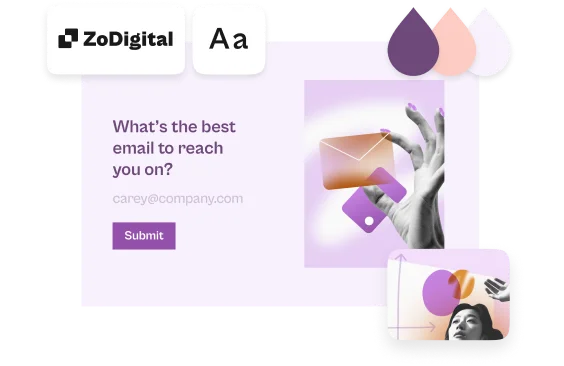7 quick writing tips to make your forms convert
Picture this: It’s Monday morning; you open your email to find your boss is entrusting you to make the Best. Survey. Ever. Naturally, you turn to Typeform.
The adrenaline is rushing through your veins. Finally, a project you can lead and an excuse to get out of going to your friend’s poetry reading (or one-act play, or whatever). You’re ready to conquer the world. You open a new form only to realize you haven’t got the slightest clue how to write a survey, let alone a good one.
Rest easy, kind friend. Professor of Social Interaction Elizabeth Stokoe from Loughborough University has provided some tips on how to write great forms…
1. Begin with a question.
Many interactions start with a greeting and a question – Hello, how are you? Was your weekend alright? Why didn’t you make it to my poetry reading?
Questions beg for answers, which make them engaging. Starting with a question on your Welcome Screen is a great way to draw someone in from the beginning.
2. Give a reason and encourage action.
A form is only useful if you get responses. Encourage potential respondents by explaining how they’ll benefit from filling out the survey. Maybe they’ll get early access to an event or will help out a worthy cause.
Showing their benefit early is important, so think about adding it to your Welcome Screen. Placing a ‘Call-to-action’ (CTA) in the buttons of your form is a good idea. Make sure it’s specific to the form and the action the respondent is taking (signing up for a newsletter, giving feedback, etc.) to avoid any confusion and increase impact.
3. Speak naturally and know your audience.
Everyone, including brands, has their own voice. Depending on your subject matter or industry, you may want to be more or less formal. But, at the very least, avoid sounding like a robot.
Here are some tips:
- Use question marks when asking questions. Seems obvious, but how often do forms just say “name”?
- Use “and” prefaces (as well as … ellipsis) to connect sequences of questions (e.g. what’s your name? … and age? … and email?, etc.).
- Use “so” prefaces at the start of ‘main purpose’ questions (e.g. “so, what kind of cake would you like to order? ?” Instead of “type of cake”).
- Use active voice when possible (e.g. “we’ll send an email” instead of “an email will be sent”).
- Contract words, depending on how formal/ informal your form is (e.g. “can’t” instead of “cannot”).
- Use common words not overly-formal or obscure ones (e.g. “many” instead of “a plethora”).
Make sure you’re designing questions for the audience you’re speaking to. If it’s an industry-specific form, use the specialized language that you know you share. If your audience is poets, maybe don’t make jokes about getting out of your friend’s reading.
No matter the case, make sure it’s language your audience is used to and doesn’t feel forced or contrived. (e.g. “I’m pretty hungry” vs “I’m ravenous, absolutely RAVENOUS!”)
4. Add a Description.
The Description box is an underused part of a form. It allows you to give more information with a question, without cluttering the main text and can be edited per question.
Avoid using the description to further explain the question. If the question makes no sense without the description, then you should rethink how both are written. Instead, use it as a way to reassure your respondents. Something like, “be as candid as you like” could be a good option when asking for an opinion.
5. Make it responsive.
One of the best things about Typeform is the ability to make forms conversational through features like Recall Information and Logic. For example, adding Recall Information allows you to use your respondent’s name at the start of the form, just like a conversation (remember that names are a summons, so don’t keep summoning your respondent once you’ve used it to greet them). Logic allows you to show relevant questions based on answers the respondent gives.
Communicating emotion in your questions is a nice touch, too. Saying things like, “We’re so excited…!” or “This might be a little uncomfortable…” is part of natural language, so should be reflected in your form. Do be careful not to overdo it. The idea is authenticity, so, if it starts to feel disingenuous, that’s a problem.
6. Be concise and show progress.
Forms with tons of questions can be arduous. With that in mind, it’s important to only ask what’s needed.
Let your respondent know where they are in the overall form, too. Think about it like chapters in a book; each time you reach a new chapter, it’s like a little milestone. They’re silent reminders you’re making progress and help propel you forward. Connect questions inside ‘chapters’ together using the ‘and’ and ‘so’ prefaces mentioned earlier. Close chapters with markers of progress (e.g., “Great, thanks.”) before starting the next one, and use a preface like “Finally, …” towards the end.
7. Customize your end screen.
The End Screen is the last thing your respondent will see. Let your respondents know what actions to expect from you. You can edit the text in the End Screen, add Social share icons, redirect respondents, and customize the button.
That’s it! You’ve seen our list of tips and tricks. Now the only thing left to do is start building your own form. We even have a handy template gallery to get you started 🙂


